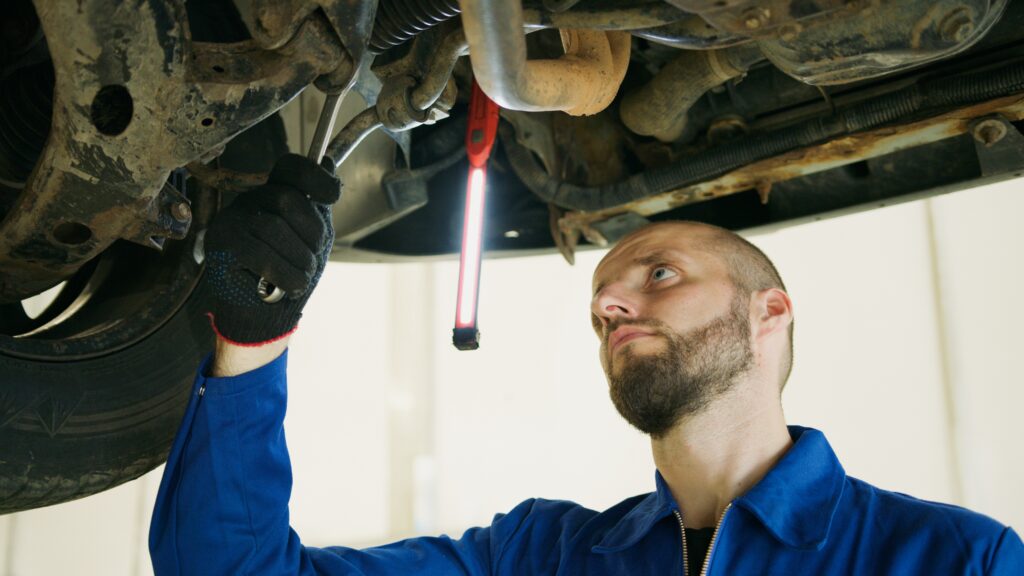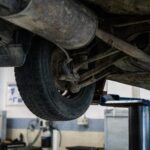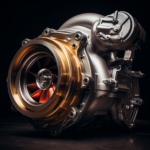At its core, a trailing-arm suspension consists of horizontal arms that connect the chassis to the wheel hub. These arms, aptly named “trailing arms,” serve as a vital link between the car body and the rear axle. By acting as a pivot joint for various forces at play while driving – such as steering inputs, braking forces, and even rough road conditions – trailing arms ensure that your vehicle remains firmly planted on the ground.
One of the standout features of this suspension system is its ability to enhance ride comfort. Unlike some other suspension setups that prioritize sporty handling but compromise on smoothness, trailing-arm suspensions strike an excellent balance between both aspects. Whether you’re cruising down city streets or venturing off-road in an adventurous SUV, this type of suspension delivers a comfortable ride without sacrificing control.
Trailing-arm suspensions can be found in a wide range of vehicles, from everyday passenger cars to rugged off-road monsters. Regardless of their application, these suspensions excel at reducing body roll during cornering maneuvers. This means that when you take those tight bends with confidence, you can thank the trailing-arm suspension for keeping your vehicle steady and composed.
Definition and Purpose of Trailing-Arm Suspension
Trailing-arm suspension is a crucial component in the automotive world that connects the axle or wheel hub to a vehicle’s chassis. This innovative system plays a vital role in controlling the vertical movement of the wheels while maintaining proper alignment. Let’s delve deeper into why trailing-arm suspension is so significant and how it enhances your driving experience.
Connecting Axle to Chassis: The Backbone of Stability
One of the primary functions of trailing-arm suspension is to connect the axle or wheel hub securely to the vehicle’s chassis. By doing so, it provides a stable foundation for the wheels, allowing them to move independently. This independent movement greatly improves handling and stability, especially when navigating through curves or uneven terrains.
Imagine cruising down a winding road with confidence as each wheel adapts seamlessly to changes in terrain. With trailing-arm suspension, you can rest assured that your vehicle will maintain its composure even on bumpy surfaces, ensuring maximum control at all times.
Smooth Ride Quality: Absorbing Shocks with Grace
No one enjoys feeling every bump and dip on the road while driving. That’s where trailing-arm suspension truly shines – it absorbs shocks from uneven road surfaces, enhancing ride quality for both driver and passengers alike.
Picture yourself gliding effortlessly over potholes without jarring impacts being transferred into the cabin. Thanks to its design, trailing-arm suspension minimizes vibrations and harshness by effectively dampening road irregularities. This not only improves comfort but also reduces fatigue during long journeys, making every drive an enjoyable experience.
Independent Wheel Movement: Unleashing Agility
Trailing-arm suspension allows each wheel to move independently from one another, granting your vehicle enhanced agility and responsiveness on any terrain. Whether you’re maneuvering through tight city streets or tackling off-road adventures, this feature ensures optimal tire contact with the ground at all times.
With independent wheel movement, your vehicle can better adapt to uneven surfaces, maintaining stability and traction. This translates into improved cornering capabilities, reduced body roll, and increased overall control.
Weight Distribution: The Key to Balance
Achieving proper weight distribution is crucial for optimal handling and balance in any vehicle. Trailing-arm suspension plays a pivotal role in evenly distributing the weight across all wheels, ensuring that no wheel is overloaded or underutilized.
By keeping the weight balanced, this suspension system helps prevent excessive wear on specific components and tires. It also contributes to improved braking performance by ensuring even pressure distribution across all four wheels. So whether you’re accelerating or coming to a stop, trailing-arm suspension assists in maintaining stability and control throughout your journey.
Benefits of Trailing-Arm Suspension
Better Traction for a Smoother Ride
Trailing-arm suspension has got your back. One of the key benefits of this type of suspension is its ability to keep the tires in constant contact with the road surface, providing better traction. This means that even when you navigate through bumpy terrain or encounter uneven surfaces, your vehicle remains firmly planted on the ground. By keeping all four wheels connected to the road, trailing-arm suspension enhances stability and control, allowing you to maneuver with confidence.
Reduced Body Roll for Enhanced Stability
Nobody likes feeling like they’re being thrown around in their vehicle while taking sharp turns. With trailing-arm suspension, you can say goodbye to excessive body roll during cornering. This type of suspension system effectively reduces body roll by distributing weight evenly across the chassis during lateral movements. As a result, your vehicle becomes more stable and predictable when navigating curves or making sudden maneuvers. Whether you’re cruising along winding roads or tackling hairpin bends, trailing-arm suspension ensures that your ride remains steady and comfortable.
Improved Braking Performance for Greater Safety
Trailing-arm suspension takes center stage once again. By preventing excessive weight transfer during braking, this suspension system allows for optimal distribution of forces across all four wheels. This translates into improved grip and enhanced stopping power as each tire maintains maximum contact with the road surface. So whether you need to make a quick stop at high speeds or navigate slippery surfaces, trailing-arm suspension ensures that your vehicle responds promptly and safely.
Enhanced Ride Comfort on Any Terrain
Driving over rough roads can be quite an uncomfortable experience if your vehicle isn’t equipped with the right suspension system. Luckily, trailing-arm suspension excels at absorbing bumps and vibrations from the road surface, significantly enhancing ride comfort. The design of this type of suspension allows it to effectively isolate the cabin from road imperfections, providing a smoother and more enjoyable ride for you and your passengers. So whether you’re driving on pothole-riddled city streets or tackling off-road adventures, trailing-arm suspension ensures that you can enjoy a comfortable journey.
Better Control for Off-Road Adventures
For those who love to venture off the beaten path, trailing-arm suspension is a game-changer. Its design offers better control over rough terrains, making it an ideal choice for off-road vehicles. Whether you’re crawling over rocks or traversing muddy trails, trailing-arm suspension keeps all four wheels in contact with the ground, maximizing traction and minimizing wheel spin. This means that you can conquer challenging terrain with confidence, knowing that your vehicle’s suspension system has got your back.
Optimized Space Utilization for Versatile Design
Manufacturers need flexibility to optimize space utilization efficiently. Trailing-arm suspension provides just that. Its design allows for greater freedom in positioning various components within the vehicle’s chassis. By taking advantage of this versatility, manufacturers can maximize interior space while ensuring optimal weight distribution and balance. This not only enhances comfort but also allows for innovative designs that cater to different needs and preferences.
Signs of a Broken or Damaged Trailing Arm
Unusual Noises: Clunks and Squeaks
If you start hearing strange clunking or squeaking noises coming from the rear suspension of your vehicle, it could be an indication of a broken or damaged trailing arm. These unusual sounds are often caused by worn-out joints within the trailing arm assembly. Over time, these joints can become loose or deteriorate, resulting in the telltale noises that you may hear while driving. Don’t ignore these sounds, as they can be early warning signs of a more serious problem.
Uneven Tire Wear and Abnormal Movement
Another sign to watch out for is uneven tire wear or abnormal movement in your tires. When a trailing arm is damaged, it can cause the tires to wear unevenly due to improper alignment and suspension movement. You might notice that one tire is wearing down faster than the others, indicating a problem with the suspension system. If you observe abnormal tire movement while driving, such as excessive bouncing or wobbling, it’s likely related to a faulty trailing arm.
Excessive Vibration: A Shaky Situation
Feeling excessive vibration through the steering wheel or seat is another clear indication that something may be wrong with your trailing arm. A damaged trailing arm can disrupt the smooth operation of your vehicle’s suspension system, leading to increased vibrations transmitted through various components. If you find yourself constantly gripping the steering wheel tightly due to an unsettling amount of vibration or experiencing an uncomfortable ride with noticeable shaking sensations, it’s time to have your trailing arm inspected.
Vehicle Pulling: Going Off Course
When your vehicle starts pulling to one side while driving on a straight road without any input from you, it could be related to a broken or damaged trailing arm. The purpose of this suspension component is to maintain proper alignment and stability for all four wheels. However, if one side of the trailing arm is compromised, it can cause an imbalance in the suspension system, resulting in your vehicle veering off course. This pulling sensation can be dangerous and should be addressed promptly to ensure safe driving conditions.
Reduced Handling Ability and Poor Stability
A broken or damaged trailing arm can significantly impact your vehicle’s handling ability and stability. As the trailing arm plays a crucial role in maintaining control during cornering and maneuvering, any issues with this component can lead to reduced responsiveness, increased body roll, and poor overall stability while driving. If you notice that your vehicle feels less stable around turns or has become more difficult to handle, it’s likely due to a problem with the trailing arm.
Visible Damage: Corrosion and Beyond
Last but not least, visible damage or corrosion on the trailing arm itself is a clear sign that it requires attention. Inspect the area around the trailing arm for any signs of physical damage such as cracks, bends, or rust. Corrosion is particularly concerning as it weakens the structural integrity of the trailing arm over time. If you spot any visible damage or signs of corrosion on this vital suspension component, it’s essential to have it inspected by a professional mechanic immediately.
Maintenance Tips for Trailing-Arm Suspension
Inspect Regularly, Avoid Costly Repairs
Inspecting your trailing-arm suspension regularly is crucial to ensure the safety and performance of your vehicle. Look out for any signs of damage or wear on the trailing arms themselves. These components bear a significant amount of weight and stress, so it’s important to catch any issues early on. Check for cracks, bends, or excessive rust that could compromise their integrity.
In addition to inspecting the trailing arms, pay attention to the bushings and joints. These parts can wear out over time and may need lubrication to prevent squeaking or binding. Apply a suitable lubricant recommended by your vehicle’s manufacturer to keep them running smoothly. By taking these simple steps, you can avoid costly repairs down the road.
Alignment Matters: Keep Your Wheels in Line
Proper alignment is essential for optimal wheel positioning and overall handling of your vehicle. Misalignment can cause uneven tire wear, poor steering response, and even affect fuel efficiency. To maintain proper alignment with a trailing-arm suspension system, it’s important to check it regularly.
You have two options. If you choose the latter, here are some steps you can follow:
- Find a level surface where you can safely park your vehicle.
- Measure the distance between each front tire and rear tire at the same point (e.g., center of wheel hub).
- Compare these measurements; they should be within manufacturer-specified tolerances.
- If there is a significant difference in measurements, consult a professional for further inspection and adjustment.
Remember that accurate alignment requires specialized equipment; therefore, professional service is recommended if you’re unsure about performing DIY checks.
Prompt Replacement: Don’t Delay
Worn-out or damaged components in your trailing-arm suspension system should be replaced promptly to maintain its effectiveness and safety. If you notice any signs of wear, such as excessive play in the joints or bushings, it’s essential to address the issue without delay.
Replacing components can vary depending on your vehicle’s make and model, but common parts that may need replacement include:
- Trailing arms
- Bushings
- Joints
- Bolts and nuts
Consult your vehicle’s manual or a trusted mechanic for specific instructions on how to replace these components. By addressing worn-out or damaged parts promptly, you can prevent further damage to your suspension system and ensure a smooth ride.
Keep It Clean: Dirt and Debris Beware
Trailing-arm suspension systems are exposed to various elements while driving, including dirt, debris, and corrosive substances. These contaminants can accelerate wear and compromise the performance of your suspension system. Regular cleaning is essential to maintain its longevity.
Here are some steps you can take to keep your trailing-arm suspension clean:
- Use a hose or pressure washer to remove loose dirt and debris from the components.
- Scrub with a mild detergent solution using a soft brush or sponge.
- Rinse thoroughly with water to remove any soap residue.
- Dry the components completely before applying lubrication or protective coatings.
By keeping your suspension system clean from dirt and debris, you’ll reduce the risk of premature wear and extend its lifespan.
Follow Manufacturer’s Recommendations: Don’t Skip Maintenance Intervals
Manufacturers provide maintenance recommendations for specific intervals based on their engineering expertise. Following these guidelines is crucial for ensuring the longevity and optimal performance of your trailing-arm suspension system.
Refer to your vehicle’s manual for maintenance schedules related to the trailing-arm suspension. These recommendations may include inspections, lubrication intervals, alignment checks, and component replacements at certain mileage milestones.
By adhering to these manufacturer-recommended maintenance intervals, you’ll have peace of mind knowing that you’re taking proactive steps towards preserving the integrity of your suspension system.
Common Issues and Troubleshooting for Trailing-Arm Suspension
Excessive play in the trailing arm bushings may cause instability or noise
One common issue that can arise with trailing-arm suspension is excessive play in the trailing arm bushings. These bushings are responsible for connecting the trailing arms to the chassis of the vehicle, providing stability and support. When these bushings wear out or become damaged, they can develop excessive play, leading to instability and noise.
If you notice your vehicle feeling unstable or hear unusual noises coming from the rear suspension, it’s important to inspect the condition of the trailing arm bushings. Excessive play can cause a loss of control while driving, making it crucial to address this issue promptly.
To troubleshoot this problem, visually inspect the bushings for signs of wear or damage. Look for cracks, tears, or any other indications that they may need replacement. Check for any looseness by attempting to move the trailing arms by hand. If there is noticeable movement or if you hear clunking sounds when doing so, it’s likely that the bushings are worn out and need to be replaced.
Worn-out shock absorbers can lead to poor ride quality and reduced control
Another common issue associated with trailing-arm suspension is worn-out shock absorbers. The shock absorbers play a vital role in dampening vibrations and controlling the movement of the suspension system. Over time, these components can deteriorate due to constant use and exposure to various road conditions.
When shock absorbers become worn-out or damaged, they can result in poor ride quality and reduced control over your vehicle. You may experience excessive bouncing or swaying while driving, making it difficult to maintain stability on the road.
To troubleshoot this issue, perform a visual inspection of your shock absorbers. Look for signs of leakage or physical damage such as dents or cracks in their housing. Pay attention to how your vehicle behaves while driving. If you notice excessive bouncing or a lack of control, it’s likely that the shock absorbers are worn out and need replacement.
Misalignment of the wheels can result in uneven tire wear and handling issues
Misalignment of the wheels is another issue that can affect trailing-arm suspension systems. When the wheels are not properly aligned, it can lead to uneven tire wear and handling problems. This misalignment can occur due to various factors such as hitting potholes or curbs, improper installation of suspension components, or general wear and tear.
If you notice that your tires are wearing unevenly or experiencing abnormal tread wear patterns, it’s important to have your wheel alignment checked. Misaligned wheels can cause unnecessary strain on the trailing-arm suspension system, leading to premature component failure and reduced handling performance.
To troubleshoot this issue, take your vehicle to a reputable auto shop for a professional wheel alignment service. They will use specialized equipment to measure and adjust the angles of your wheels according to manufacturer specifications. By ensuring proper alignment, you can prevent further damage to your trailing-arm suspension system and improve overall handling.
Corrosion on the trailing arms can weaken their structural integrity over time
Corrosion is a common problem that affects many different parts of a vehicle, including trailing arms in a trailing-arm suspension system. Over time, exposure to moisture, road salt, and other corrosive elements can cause rust and deterioration on these components.
When corrosion occurs on the trailing arms, it weakens their structural integrity. This compromises their ability to support the weight of the vehicle properly and may lead to premature failure or breakage.
To address this issue, regular inspections are crucial. Check for signs of corrosion on the trailing arms by visually inspecting them for any areas with flaking paint or visible rust spots. If corrosion is present, it’s essential to take appropriate action promptly.
In some cases, minor surface corrosion can be treated by sanding and repainting the affected areas. However, if the corrosion has caused significant damage or compromised the structural integrity of the trailing arms, replacement may be necessary to ensure safe operation of your vehicle.
Overloading the vehicle beyond its capacity can put excessive stress on the suspension system
One common issue that can lead to problems with trailing-arm suspension is overloading the vehicle beyond its recommended capacity. Every vehicle has a maximum weight limit specified by the manufacturer, and exceeding this limit puts excessive stress on various components, including the suspension system.
When a vehicle is overloaded, it places additional strain on the trailing-arm suspension system.
Upgrading and Modifying Trailing-Arm Suspension Systems
We discussed the definition and purpose of these systems, highlighting their benefits and the signs of a broken or damaged trailing arm. We also delved into different types of trailing-arm suspensions and provided maintenance tips to ensure optimal performance.
It is crucial to understand that maintaining your vehicle’s suspension system is essential for a smooth and safe driving experience. By following the recommended maintenance practices, you can prolong the lifespan of your trailing-arm suspension and prevent potential issues.
It is advisable to consult with an experienced professional or mechanic who specializes in this area. They can provide valuable insights and guidance based on your specific needs and preferences.
Remember, safety should always be a top priority when making any modifications to your vehicle’s suspension system. Ensure that any upgrades or modifications comply with local regulations and are carried out by qualified individuals using high-quality components.
Aftermarket or Replacement Suspension Parts
I recommend using Tire Rack to buy suspension components. Whether you want to perform the maintenance yourself or just save money on the parts so your mechanic doesn’t upcharge you, Tire Rack is a great place to shop. They guarantee proper fitment for your vehicle by using a program where you can enter the year, model, make, and trim of your vehicle. They also offer a 30-day return policy on unused items and fast free shipping on every order over $50.

FAQs
Can I upgrade my stock trailing-arm suspension myself?
While some basic maintenance tasks can be performed by car enthusiasts with appropriate knowledge and tools, upgrading a stock trailing-arm suspension system typically requires advanced technical expertise. It is recommended to consult with professionals who specialize in such modifications to ensure safety and optimal results.
How often should I inspect my trailing-arm suspension for signs of damage?
Regular inspections are crucial in identifying early signs of damage or wear in your trailing-arm suspension system. It is advisable to include these inspections as part of routine maintenance checks or whenever you notice unusual noises, vibrations, or handling issues while driving.
What are some common aftermarket upgrades available for trailing-arm suspensions?
Aftermarket upgrades for trailing-arm suspensions can include adjustable control arms, performance shocks, sway bars, and bushing replacements. These upgrades aim to enhance the suspension’s performance, adjustability, and overall handling characteristics.
Can modifying my trailing-arm suspension affect my vehicle’s warranty?
Modifying your vehicle’s suspension system can potentially void or impact your manufacturer’s warranty. It is recommended to review your warranty terms and consult with authorized dealers or professionals who can provide guidance on aftermarket modifications without compromising your warranty coverage.
Are there any specific maintenance tips for off-road enthusiasts with trailing-arm suspensions?
Off-road driving puts additional stress on the suspension system. Regularly inspecting and maintaining components such as bushings, joints, and shock absorbers is crucial for off-road enthusiasts. Consider upgrading to heavy-duty or specialized components designed for rugged terrains.
These FAQs provide insights into common concerns related to trailing-arm suspension systems and their upgrades. Remember to consult with professionals for personalized advice based on your specific vehicle and requirements.





